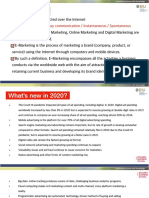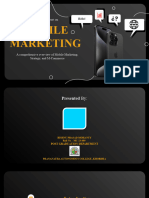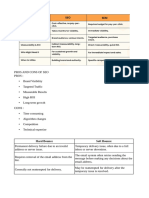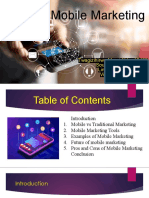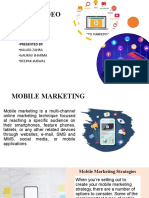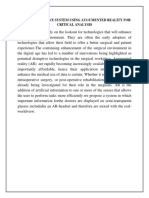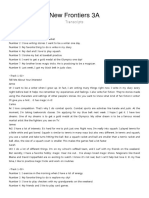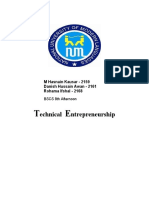Module 4
Uploaded by
Suchitra SujaModule 4
Uploaded by
Suchitra SujalOMoARcPSD|2307505
Mobile Marketing - ds its notes refere and gain knowledge
Bachelor of computer applications (Bangalore University)
Scan to open on Studocu
Studocu is not sponsored or endorsed by any college or university
Downloaded by Krishna K (suchitrasuja@gmail.com)
lOMoARcPSD|2307505
Unit 4 - Mobile Marketing
I. Mobile Marketing Overview:
Mobile marketing is any promotional activity that takes place on smartphones
and other handheld devices such as tablets. Mobile marketing aims to reach an
audience of mobile device users through methods such as push notifications,
marketing emails, and advertisements.
Mobile marketing vs. mobile advertising
Mobile marketing and mobile advertising are similar but differ in their scope
and approach.
Mobile marketing is a broader term that encompasses various strategies
and techniques to engage with and market to mobile device users.
It involves not only advertising but also other elements such as app store
optimization (ASO), push notifications, in-app messaging,
personalization and user retention tactics.
Mobile marketing focuses on building relationships with users, delivering
personalized experiences and maximizing user engagement.
Mobile advertising specifically refers to the practice of displaying ads on
mobile devices to promote products, services, or brands (in this context,
mobile apps).
It primarily focuses on improving brand awareness and/or driving
conversions through targeted advertising campaigns, programmatic media
buying, bidding processes, and optimizing key performance indicators
(KPIs) like cost-per-click (CPC) or cost-per-action (CPA).
While mobile advertising is a component of mobile marketing, mobile
marketing encompasses a broader range of strategies beyond just
advertising to foster comprehensive mobile user experiences and long-
term user relationships.
Downloaded by Krishna K (suchitrasuja@gmail.com)
lOMoARcPSD|2307505
Why mobile marketing is important: The advantages of mobile marketing
With millions of apps available in app stores, mobile marketing is a necessity to
attract and retain app users. Mobile marketing campaigns help mobile apps
showcase their unique features and benefits, communicate with users in real-
time, and provide personalized experiences that enhance user satisfaction.
There are many benefits of mobile marketing, including
1. Increased visibility and awareness: Mobile marketing enables you to
increase the visibility of your mobile app among your target audience.
Through various marketing channels such as ASO, mobile ads, social
media promotion and influencer partnerships, we can drive more app
downloads and attract users to discover and install the app.
2. User acquisition and retention: A good mobile marketing strategy can
help you acquire new app users and retain existing ones. By leveraging
targeted advertising campaigns, referral programs and personalized
messaging we can attract new users while engaging and retaining our
current user base and minimizing churn.
3. Engagement and conversion: By sending timely and relevant messages,
app updates, promotions and personalized recommendations, mobile
marketing encourages users to interact with the app more frequently and
for longer durations. This increased engagement fosters a deeper
connection between users and the app leading to higher user retention and
loyalty. Additionally, mobile marketing tactics like optimized user
experiences, streamlined checkout processes and mobile payment
solutions contribute to smoother and more convenient app usage resulting
in improved conversion rates.
By leveraging the power of mobile marketing, mobile apps can maximize
their reach, increase app downloads, drive user engagement, and
ultimately achieve long-term success in the highly competitive app
market.
Downloaded by Krishna K (suchitrasuja@gmail.com)
lOMoARcPSD|2307505
Types of mobile marketing
Mobile marketing strategies vary across a wide range of platforms, from social
media to mobile-optimized websites and mobile apps, all offering unique
marketing and advertising options, such as:
In-app marketing: Ads, sponsored content or in-app messages which leverage
the captive audience and engaged user base within an app.
Social media marketing: Organic social media marketing involves regularly
creating and sharing valuable and relevant content such as posts, images,
videos, and stories, to connect with followers and build a community. Organic
social media marketing focuses on fostering genuine relationships, encouraging
user-generated content (UGC) and leveraging the power of word-of-mouth
marketing.
Paid social media marketing refers to the placement of ads on social media
platforms to promote a brand, reach a targeted audience, and achieve specific
marketing goals. It involves customizable ad formats, call-to-action buttons, and
analytics for performance tracking.
Location-based marketing: Communications (notifications or ads) that appear
on mobile devices based on a user’s location relative to a specific area. There
are several types of location-based marketing including proximity marketing,
which utilizes technologies like Bluetooth, Wi-Fi to detect and engage with
users who are in close proximity to a physical location, and geofencing which
sets virtual boundaries or perimeters around specific locations using GPS or
cellular data.
Search engine marketing: Organic search marketing focuses on optimizing a
website's content, structure, and relevance to improve its visibility and rankings
in search engine results pages (SERPs) organically.
Paid search marketing, also known as pay-per-click or PPC marketing involves
advertisers bidding on specific keywords to display their ads prominently in
search engine results for those words.
SMS marketing: Texting a user’s phone number with specific offers or
notifications of upcoming deals. SMS marketing can also be location-based.
WhatsApp marketing functions in the same manner but relies on the use of
WhatsApp’s application rather than SMS.
Downloaded by Krishna K (suchitrasuja@gmail.com)
lOMoARcPSD|2307505
Display ads: Graphical advertisements that appear on websites or apps. They
typically consist of images, text, and sometimes interactive elements when
using rich media formats.
QR code marketing: Quick response (QR) codes are scannable barcodes that
can be scanned by a smartphone to bring users to websites landing pages,
product pages or digital content allowing businesses to engage with their
audience and track engagement metrics.
Push notification marketing: Real-time messages sent directly to users'
devices, even when they are not actively using the app.
Email marketing: Messages to a group of subscribed users via email designed
to update and engage subscribers, nurture leads, boost brand loyalty and drive
business growth.
Downloaded by Krishna K (suchitrasuja@gmail.com)
lOMoARcPSD|2307505
How does mobile marketing work?
To market an app, a mobile marketer works with the follow ways:
1. Complete mobile market research to gather valuable insights and data
about mobile consumer behaviour, target audience preferences, and
competitor activity.
2. Examine current mobile marketing trends such as augmented reality
(AR), artificial intelligence (AI) and user-generated content.
3. Develop a mobile marketing strategy inclusive of several types of mobile
marketing to achieve outlined objectives.
4. Test and run mobile campaigns using chosen mobile marketing
techniques and reliable attribution for robust analytics.
II. Mobile Advertising Strategies:
Mobile advertising is using different formats of ads suitable for mobile devices
to promote products. It helps companies reach people in real-time, receive
instant responses from customers, create shareable content, and track the results.
Downloaded by Krishna K (suchitrasuja@gmail.com)
lOMoARcPSD|2307505
Why is mobile advertising important?
There are around 6.6 billion smartphone users worldwide. They use their
mobile devices to explore products, search for necessary information and
order different items.
That’s why it’s crucial to adopt mobile advertising. There are many
reasons to consider mobile ads for business such as,
First of all, people spend around five to six hours on their smartphones
during their spare time every day.
This means that they search for information using Google or social media
platforms. Customers use their cell phones to order from
famous eCommerce platforms like Amazon and eBay and buy food from
grocery stores and restaurants.
Brands that develop mobile campaigns to introduce their products and
lead consumers toward a sale, see a considerable increase in their profits.
With location data and search history, businesses can understand the
needs of their prospects and address them.
Entrepreneurs can leverage personalization and deliver targeted messages
to the right people.
How does Mobile Advertisement Work?
To extract the best out of a mobile advertisement, you need to use clear
formatting, compelling ad banners, and keep the customers’ perspective in
mind. Always try to make your customers’ experience simple, immediate, and
actionable. Personalize your message.
To make your mobile advertisement efficient, make sure the following points
are taken care of −
Make interactive ads. Encourage audience for sign-ups and grab offers.
Geo-target your mobile ad campaigns to make them more relevant and to
convert every hit on your ad.
Make it social. Add or refresh social sharing to make it viral, thus
increasing conversion rate.
Choose the right channels. Focus on trending channels and media that
may give you higher yield.
Keep performing micro-experiments to identify what are the critical
factors affecting audience’s behaviour?
Downloaded by Krishna K (suchitrasuja@gmail.com)
lOMoARcPSD|2307505
Advantages and Disadvantages of Mobile Advertising
Advantages
Messages delivered to people in real-time.
Minimum content to achieve results.
Instant responses from leads.
Shareable content.
Higher reach.
Increased revenue.
Targeted messaging.
Personalized offers.
The possibility of online payments to conduct instant transactions.
Multiple functions (brands can educate about their product, ask for
feedback, advertise promotions, and sell).
Disadvantages:
Mobile ads can be interruptive.
Some people can be irritated because ads might interrupt their
experiences online.
People even use mobile ad-blocking apps to avoid seeing advertising on
sites they visit.
If we fail to deliver timely and relevant messages to the customers, the
brand can shape a negative first impression on potential customers. That’s
why you always need to avoid typos and show ads at the right time.
Since phones are different in their shapes and sizes, we can’t be sure that
users will see them in the format we wanted them to be. This can also be
a problem for users.
Types of Mobile Advertising
Banner ads. These are image-based ads. Banners are embedded into the web pages
and aimed at driving the number of visitors and generating traffic. We can find these
ads at the top or bottom of the screen of the mobile device on a website or online
media property. Entrepreneurs can share their advertising campaigns with users at a
low cost. As a result, we can increase brand awareness without interrupting
customers.
Video ads. A mobile video ad is a pre-, mid-, or post-roll video from 15 to 30 seconds
in length you can see on YouTube and across sites and applications that run on
Google video partners. Users can tap the video to watch it. A creative, unique and
relevant video can increase engagement and establish an online presence.
Native ads. These are ads that match the platform they are used in. They can be found
in social media feeds or recommended content on websites. Native ads fit the media
Downloaded by Krishna K (suchitrasuja@gmail.com)
lOMoARcPSD|2307505
format perfectly and are non-intrusive. There are many ways to promote the business
with native advertising. You can implement "In-Feed" ads, content recommendations,
and search and promoted listings.
Swipe ads. These ads perfectly suit online shopping platforms and companies
engaged in eCommerce. They help showcase a product, demonstrate how to use it,
and provide a product tour for users. Once customers see this type of mobile
advertising, they can swipe it to see all the images a company provides. Each image
includes a link to a separate landing page. This format is highly engaging and can
bring new prospects to your business.
Interstitial ads. These are full-screen ads that appear when a user loads or closes the
app, during the transition to the next game level or the pause. This type of mobile ad
perfectly fits the screens of various mobile devices and attracts customers’ attention.
Once we succeed in creating quality content with informative visuals and compelling
copy for the interstitial ads, we can gain impressions and more click-through rates.
III. Mobile App Marketing:
Mobile applications are in rage today and will be for a long time to come. The
reason is simple – a mobile application is more personal than a website.
Customers download an application if they like what it offers or if they have a
need for it. That’s one of the reasons why a mobile application often brings in
more revenue to a business than a website.
What is a Mobile App?
A mobile app is a computerized program developed especially to run on mobile
devices including mobile phones, tablets, smartphones, etc.
However inviting as it may sound, you should take a step backwards and
carefully analyze — does your business need a mobile application? For
instance, if you have an online website primarily delivering content to your
customers, then you might want to go for a mobile website rather than an
application. However, for certain businesses such as a game which requires the
use of a camera or an e-commerce site that uses geo-location data might get
benefited tremendously with a mobile app.
How does a Mobile App Work?
A mobile application can create wonders for your business, if you always keep
the customers in focus. For instance, if customers are primarily business
professional who use a Blackberry phone, then a gaming application might not
Downloaded by Krishna K (suchitrasuja@gmail.com)
lOMoARcPSD|2307505
appeal to them. The bottom-line is that we have to carefully examine our
customers’ uses/interests before designing a mobile application.
Once we’ve decided to develop a mobile application strategy, you need to take
care of the following two important points −
Design Your App for Multiple Devices and Platforms
Two of the most popular mobile operation software are ‘the Apple OS’
and ‘Android OS’. However, Microsoft OS is also notable. . So, while
designing your application, make sure that it runs on all these three top
operating software. Once, you have done this, you need to pay attention to other
design details such as the screen sizes of different mobile devices, the usability
of the interface and so on.
Different Ways to Market Your Mobile Application
There are a number of ways to market your mobile application. The first one
that comes to mind is of course the Apple App Store. There is also Android
Marketplace. These stores are some of the best places to showcase your mobile
apps. You can also market them on direct download sites such as
download.com, getjar.com etc.
Benefits of Mobile App
The most powerful aspect of a mobile application is the idea of
personalization. From being a mere website, one becomes a personal tool that
helps our customers to do a number of activities ranging from online purchasing
to playing a game. The whole process of sales is turned on its head and our
company develops an intimate relationship with the customers who will keep
paying us with in-app purchases, and also popularizing the name of our brand
via word-of-mouth.
The reach of mobile advertisement is growing much faster than any other mode
of advertisement. Sending promotional text messages about different products
and services is the simplest and the quickest way to reach a larger section of
your customer base.
Downloaded by Krishna K (suchitrasuja@gmail.com)
lOMoARcPSD|2307505
IV. Location Based Marketing:
Location-based marketing allows organizations to target consumers at
a granular, person level with online or offline messaging based on their
physical location. Using location data, marketing teams are able to reach
consumers based on qualifiers like proximity to a store, events happening in
their region and more.
Location-based marketing has proven effective across customer
lifecycles – from discovery and purchase, to engagement and retention.
When used properly, location-based marketing allows marketers to hone in
on specific customer segments with targeted offers, while improving
customer experience for a population that increasingly values instant
gratification. For example, location-based marketing may alert a prospect
that a product they have been considering is stocked in a nearby store,
allowing them to pick it up right away.
Types of Location-Based Marketing
There are several different ways marketers can channel this location data
into their marketing efforts:
1. Geotargeting
Geotargeting is used to determine the location of a user, to
then serve them personalized messaging based on their location. If a
consumer has opted in to let an app access their location, they may
get messages in the app or push notifications based on region or
proximity to a store.
How it works
o Geotargeting is based off IP addresses. Every connected device
has a unique IP address making them identifiable. From there,
device IP addresses can be matched to country, zip code, etc. to
determine where users are located.
Benefits
o The key benefit of geotargeting is to increase customer
experience through personalization. For example, marketers can
target users based on needs specific to their location, such as
weather or local news and events.
Examples
o
A popular example of geotargeting is Google search
results. If a user searches “coffee shops,” Google will use
location data based on the IP address of the device the
search is conducted from to return information on coffee
shops in the area.
10
Downloaded by Krishna K (suchitrasuja@gmail.com)
lOMoARcPSD|2307505
Another common example of geotargeting is done by
Uber. When a user is traveling and touches down in a new
city, upon opening the app they will get a notification about
available cars in that city.
2. Geofencing
Geofencing is the creation of a boundary within a specific
region. When target audiences enter that boundary, they will become an
active target of the marketing strategy. This might mean they receive
content, offers, or some other form of messaging from the brand. An
example of a boundary is an area that encompasses a popular shopping
center at which the company has a store.
How it works
Geofencing utilizes GPS technology to create a border.
Whenever a target user crosses this border, they receive a
notification or piece of messaging.
Benefits
o Geofencing allows marketers to cover large areas, such as malls
or event spaces. With this method, marketers can target all
users that are within a certain perimeter. While less granular
than other tactics, geofencing can be a great tool if you have a
large convention or if you want to capture traffic right in front
of your store.
o Geofencing is based on real-time location data, which allows
marketers to encourage users to engage with their products, or
divert consumers from engaging with competitors.
Examples
o Retailers can use geofencing to target users near their stores to
encourage them to stop into a shop. For example, if a customer
has been reviewing a product online, they may get a notification
that the product is in stock at a nearby store.
11
Downloaded by Krishna K (suchitrasuja@gmail.com)
lOMoARcPSD|2307505
3. Beaconing
Beacons are connected devices that use Bluetooth or WIFI to connect with
predetermined applications that are operating within range of the beacon.
Beacons work well to target existing customers within a small geographic
area.
How it works
Beacons send a signal to your device that prompt a server
to send content to your device. This could be a push
notification, email, etc. For example, say a sports stadium
encourages attendees to download their app for ticketing,
concessions, etc. The venue would set up beacons to
recognize when a device with that application installed is
in range.
Benefits
Users have to be opted-in and have Bluetooth on in order
for you to take advantage of this. However, this medium
of location-based targeting does give you a more direct
communication channel with customers.
Organizations can track users indoors in a more precise
manner. This not only allows for more specific targeting,
but helps marketers get a more complete understanding of
customer behavior.
Users don’t need to be online in order to receive these
notifications.
o Examples
Stores can place beacons in aisles around the store to
send offers as consumers browse. For example, a grocery
store may use beacons to see when a consumer is in the
ice cream aisle, and then send them a deal on ice cream
cones.
12
Downloaded by Krishna K (suchitrasuja@gmail.com)
lOMoARcPSD|2307505
4. Mobile Targeting
Mobile targeting occurs when marketers target consumers with ads
on their mobile devices. Because consumers typically want to avoid
advertising, marketers aim to make their ads context specific, which can be
based on time, device or location.
How it works
o Create segments in your mobile ad platform that define who
you want to target and what qualifications to target them by
(when they enter a certain area, or are in proximity of your
store).
Benefits
o
This allows marketers to target users directly on
their devices for a more personalized connection.
Marketers often see greater returns on ad spend
using a more targeted approach.
Examples
o Social media ads that target based on location data can help
encourage visits to a store, restaurant, or event nearby.
5. Geo-Conquesting
Geo-conquesting uses location data to divert prospects away from
competitor locations. For example, car dealerships might create a boundary
around a competitor’s lot. When a target consumer comes within that
boundary, they will be sent an offer to users that encourages them to visit
the other dealer.
How it works
Geo-conquesting uses GPS technology to target
users in the proximity of your competition.
13
Downloaded by Krishna K (suchitrasuja@gmail.com)
lOMoARcPSD|2307505
Benefits
o
Organizations can win market share and new customers
by encouraging users they know are already shopping for
a product in the space to purchase from them over a
competitor.
Examples
o
Burger King used geo-conquesting to great effect,
diverting would-be McDonalds customers back to their
own restaurants. Consumers were encouraged to
download the Burger King app. When they came within
600 feet of McDonalds, the Burger King app sent a
promotion for a 1 cent whopper, and navigated customers
to the nearest location.
Reasons to Use Location-Based Marketing
Location-based marketing can offer a host of benefits to both consumers
and marketers.
Marketers can deliver more targeted messaging that grows awareness and
nurtures relationships with customers and prospects. The targeted -nature of
these ads also often result in less wasted spend. Consumers, growing
increasingly particular about which branded messaging they interact with,
get personalized offers at convenient times, thus improving their overall
experience.
A few of the key reasons marketers are using location-based tactics are:
Increase Immediate Foot Traffic
Location-based marketing can drive foot traffic for local
businesses such as retail stores or food service, by
informing users in their market of proximity and enticing
them with an offer.
Deliver more relevant ads
Marketers can use real-time location data to create more
relevant, personalized ads.This is not necessarily
restricted to where a person is physically. Location data
can also inform timing and messaging. For example,
analysis may show that a consumer is more likely to
14
Downloaded by Krishna K (suchitrasuja@gmail.com)
lOMoARcPSD|2307505
engage with an ad when they are on the train or
commuting, helping marketers determine when to serve
an ad. Location data may also inform copy and creative.
For example, marketing teams may choose to use images
of the city the target consumer lives in, rather than
generic imagery. Context and relevance have become
crucial components of messaging that is engaged with,
rather than ignored. Using these real-time insights
ensures these criteria are met.
Drive consumers away from the competition
By targeting users heading to a competitor’s business,
marketers can encourage customers to visit their store
instead, winning market share.
Create a Better User Experience
o By targeting customers when they are likely to need your
services most, you can provide them with a better user
experience.
For successful location-based marketing, it is important that marketers
consider their location in addition to the location of their customers. For
example, businesses located on a street with minimal foot traffic may not
want to invest in location tactics. Similarly, stores that are not on street
level, such as in apartment buildings or hotels, should be careful to only
target people who are visiting the building to shop. For those not interested
in visiting the store, regular alerts may cause annoyance and damage brand
reputation.
As with all marketing investments, evaluate your customer base and
impactful external factors to understand how these tactics will affect ROI,
before committing ad spend.
15
Downloaded by Krishna K (suchitrasuja@gmail.com)
lOMoARcPSD|2307505
Trends in Location Based Marketing
Marketers have begun to go beyond the common expectations of location-
based marketing by harnessing these trends.
1. Augmented Location
Augmented location allows brands to do more with location data
than just send notifications. Marketers can create experiences based on
where the user is at the moment.
For example, think of Pokémon Go. This app tracks a user’s location,
and using the camera function of their mobile device, places a digital
creature within the user’s physical space.
Brands like Yelp are also playing into this trend, allowing users to point
their camera at their current surroundings and see listings for nearby
restaurants.
2. More Investment
Another trend in location-based marketing is its increased use. Retailers
across the country are looking to invest in location-based marketing, with
nearly 60 percent of retailers saying they would focus budget here in 2019.
This said, as marketers adopt location-based tactics they are careful to
consider user privacy.
3. Beacon Technology / Proximity Marketing
As noted, beacon technology uses Bluetooth to share information with user
phones. As beacons become more advanced, marketers are leveraging them
in location-based efforts more – specifically proximity marketing.
Proximity marketing uses beacons to deliver highly-targeted messages to
users within a very small range.
Prominent developments in beacon technology come from Apple, with the
iBeacon, and Google with Eddystone-EID and Project Beacon.
4. Hyperlocal Marketing
Hyperlocal marketing tactics leverage location data and time-sensitive
insights to engage customers. Marketers are able to focus on a smaller
number of consumers in a certain town, or even on a certain block. This
makes campaigns more personalized and easier to measure. Additionally,
with personalization playing such an important role in marketing today,
hyperlocal campaigns are easier to customize to niche audiences than large,
national campaigns.
16
Downloaded by Krishna K (suchitrasuja@gmail.com)
lOMoARcPSD|2307505
Examples of Brands Using Location Based Marketing
Adidas: Adidas used location extensions in their search ads to
encourage visitors to shop at the closest store. One out of every five
people who viewed the page ended up going to a physical store,
leading to a 680% increase in ROI.
Whole Foods: Whole Foods used both geofencing and geo-
conquesting tactics to win market share and increase conversions. The
supermarket targeted buyers at nearby grocery stores with special
discounts, encouraging them to visit Whole Foods stores instead.
Similarly, shoppers already planning on going to Whole Foods or
passing by received special offers – creating better experiences for
existing customers and attracting new customers in the area. This
campaign had a 4.69 % conversion rate (the national average is
1.43%)
V. Mobile Marketing Analytics:
What are mobile marketing analytics?
Mobile marketing analytics is a process of gathering data and insights
from mobile marketing campaigns and mobile applications.
This data is then analyzed to improve marketing campaigns, optimize
user experience, and drive business growth.
Mobile marketing analytics helps organizations to understand user
behavior, preferences, and needs, which can help them create more
targeted and effective marketing campaigns.
Mobile Marketing Analytics Components
1. Mobile App Analytics:
Mobile app analytics provide insights into how users are
interacting with an organization’s mobile application.
These insights can help organizations to identify areas for
improvement, such as usability, engagement, and retention.
Mobile app analytics can also help organizations to understand user
behavior, preferences, and needs.
Common metrics used in mobile app analytics include active users,
retention rate, time spent in the app, user flow and app crashes.
17
Downloaded by Krishna K (suchitrasuja@gmail.com)
lOMoARcPSD|2307505
2. Mobile Web Analytics:
Mobile web analytics provide insights into how users are
interacting with an organization’s mobile website.
These insights can help organizations to identify areas for
improvement, such as page load times, user engagement, and
conversion rates.
Mobile web analytics can also help organizations to understand
user behavior, preferences and needs.
Common metrics used in mobile web analytics include bounce
rate, click-through rate, time spent on site, user flow and
conversion rate.
3. Mobile Ad Analytics:
Mobile ad analytics provide insights into how users are interacting
with an organization’s mobile advertising campaigns.
These insights can help organizations to optimize their advertising
campaigns for better performance.
Mobile ad analytics can also help organizations to understand user
behavior, preferences and needs.
Common metrics used in mobile ad analytics include impressions,
clicks, click-through rate, conversion rate, and cost per click.
4. Mobile CRM Analytics:
Mobile CRM analytics provide insights into how users are
interacting with an organization’s mobile CRM system.
These insights can help organizations to optimize their customer
relationship management processes.
Mobile CRM analytics can also help organizations to understand
user behavior, preferences, and needs.
Common metrics used in mobile CRM analytics
include customer engagement, customer retention, customer lifetim
e value, and customer satisfaction.
18
Downloaded by Krishna K (suchitrasuja@gmail.com)
lOMoARcPSD|2307505
Mobile Marketing Analytics Techniques
1. A/B Testing:
A/B testing is a technique used to compare two different versions
of a mobile marketing campaign or mobile application to determine
which one performs better.
A/B testing is commonly used in mobile app development to test
different user interfaces, layouts and features.
A/B testing can also be used in mobile advertising campaigns to
test different ad copy, images and targeting parameters.
2. Segmentation:
Segmentation is a technique used to group users based on shared
characteristics such as demographics, behaviour or preferences.
Segmentation can help organizations to create more targeted and
effective mobile marketing campaigns.
For example, an organization could segment users based on their
location, interests or past purchase history.
3. Personalization:
Personalization is a technique used to
customize mobile marketing campaigns and mobile applications
for individual users.
Personalization can help organizations to create more engaging
and relevant experiences for their users.
For example, an organization could personalize
a mobile application by providing customized content based on a
user’s interests or location.
4. Predictive Analytics:
Predictive analytics is a technique used to predict future user
behaviour based on past behaviour and other data.
Predictive analytics can help organizations to identify patterns and
trends in user behaviour which can be used to create more
effective mobile marketing campaigns.
For example, an organization could use predictive analytics to
identify users who are most likely to make a purchase and target
them with personalized offers.
19
Downloaded by Krishna K (suchitrasuja@gmail.com)
lOMoARcPSD|2307505
20
Downloaded by Krishna K (suchitrasuja@gmail.com)
You might also like
- Digital & Social Media Management GuideNo ratings yetDigital & Social Media Management Guide21 pages
- Mobile Marketing Reaching Customers On The GoNo ratings yetMobile Marketing Reaching Customers On The Go6 pages
- SR - No. Traditional Marketing Digital Marketing: Div - BNo ratings yetSR - No. Traditional Marketing Digital Marketing: Div - B21 pages
- Chapter 4 - Devices, Platforms & TechnologyNo ratings yetChapter 4 - Devices, Platforms & Technology18 pages
- Mobile Marketing: By:-Ayush Singh Tushar Sharma100% (1)Mobile Marketing: By:-Ayush Singh Tushar Sharma24 pages
- Digital Marketing UNIT 5 M.com 2nd Yr NotesNo ratings yetDigital Marketing UNIT 5 M.com 2nd Yr Notes6 pages
- Social Media Marketing & Mobile StrategiesNo ratings yetSocial Media Marketing & Mobile Strategies36 pages
- (Ebook) Mobile Marketing: Finding Your Customers No Matter Where They Are by Cindy Krum ISBN 9780789739766, 0789739763 PDF DownloadNo ratings yet(Ebook) Mobile Marketing: Finding Your Customers No Matter Where They Are by Cindy Krum ISBN 9780789739766, 0789739763 PDF Download160 pages
- Challenges in HCI Design For Immersive Environments A Systematic Literature Review100% (1)Challenges in HCI Design For Immersive Environments A Systematic Literature Review10 pages
- Chapter1 - Introduction To Virtual RealityNo ratings yetChapter1 - Introduction To Virtual Reality11 pages
- AI 教育:优势、挑战和最佳实践 - AI in Education - Benefits, Challenges, and Best Practices - Circle 阅读助手No ratings yetAI 教育:优势、挑战和最佳实践 - AI in Education - Benefits, Challenges, and Best Practices - Circle 阅读助手14 pages
- Everything About VisiARise 20241226 131645 0000No ratings yetEverything About VisiARise 20241226 131645 00009 pages
- Doctors Assistive System Using Augumented Reality For Critical AnalysisNo ratings yetDoctors Assistive System Using Augumented Reality For Critical Analysis7 pages
- E-bookonRecenttrendsinTourismandHospitality2 0No ratings yetE-bookonRecenttrendsinTourismandHospitality2 0216 pages
- Visualization in Virtual Reality: A Systematic Review: Elif Hilal Korkut Elif SurerNo ratings yetVisualization in Virtual Reality: A Systematic Review: Elif Hilal Korkut Elif Surer34 pages
- The Role of Technology in Disaster Preparedness and Risk Management. Arysbek Aizere. Grade 10No ratings yetThe Role of Technology in Disaster Preparedness and Risk Management. Arysbek Aizere. Grade 1019 pages
- The Role of 5G Technology in Transforming Communication100% (1)The Role of 5G Technology in Transforming Communication2 pages

































